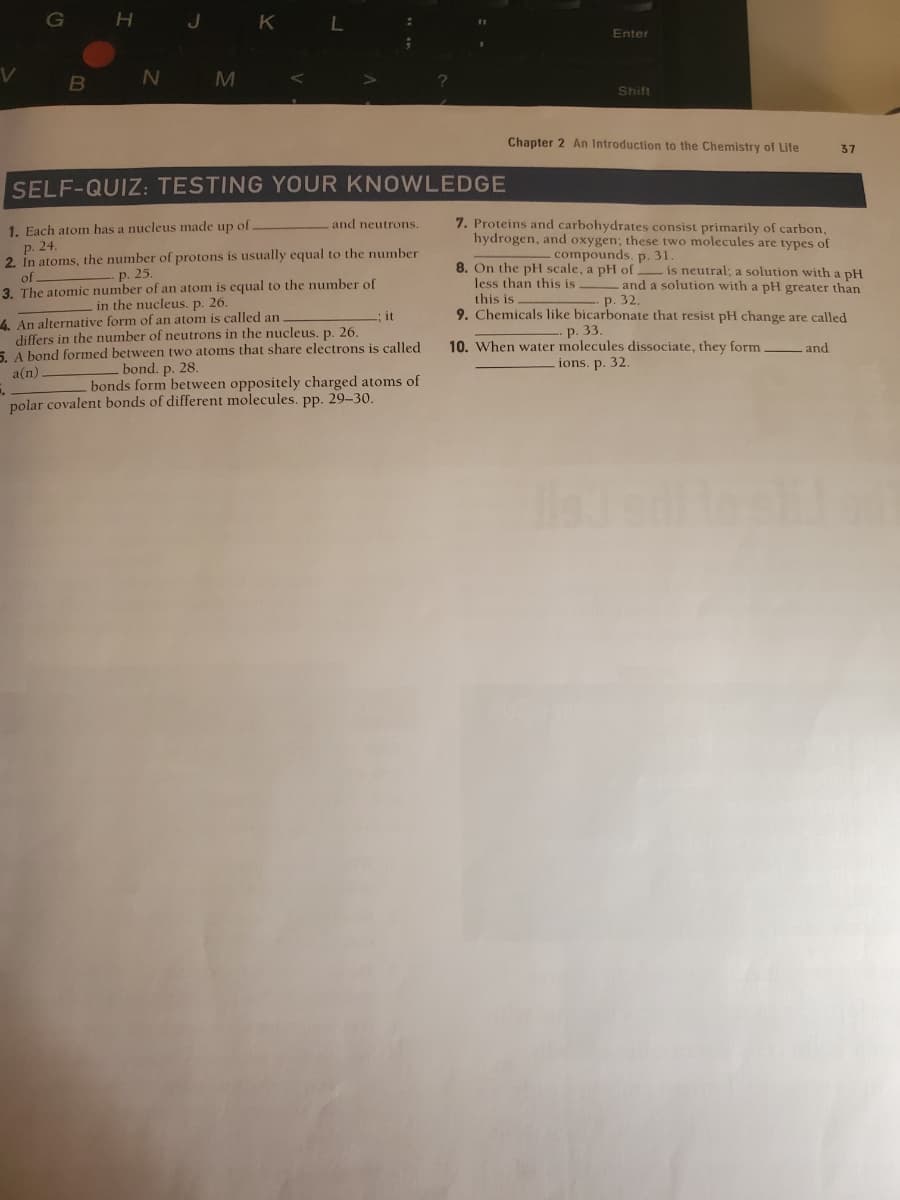7. Proteins and carbohydrates consist primarily of carbon, hydrogen, and oxygen; these two molecules are types of and neutrons. 1. Each atom has a nucleus made up of р. 24. 2. In atoms, the number of protons is usually equal to the number of B. The atomic number of an atom is cqual to the number of compounds, p. 31. 8. On the pH scale, a pH of is neutral; a solution with a pH less than this is this is 9. Chemicals like bicarbonate that resist pH change are called р. 25. and a solution with a pH greater than p. 32. in the nucleus. p. 26. An alternative form of an atom is called an differs in the number of neutrons in the nucleus, p. 26. A bond formed between two atoms that share electrons is called it Р. 3. 10. When water molecules dissociate, they form ions. p. 32. and bond. p. 28. bonds form between oppositely charged atoms of a(n) polar covalent bonds of different molecules. pp. 29-30.
7. Proteins and carbohydrates consist primarily of carbon, hydrogen, and oxygen; these two molecules are types of and neutrons. 1. Each atom has a nucleus made up of р. 24. 2. In atoms, the number of protons is usually equal to the number of B. The atomic number of an atom is cqual to the number of compounds, p. 31. 8. On the pH scale, a pH of is neutral; a solution with a pH less than this is this is 9. Chemicals like bicarbonate that resist pH change are called р. 25. and a solution with a pH greater than p. 32. in the nucleus. p. 26. An alternative form of an atom is called an differs in the number of neutrons in the nucleus, p. 26. A bond formed between two atoms that share electrons is called it Р. 3. 10. When water molecules dissociate, they form ions. p. 32. and bond. p. 28. bonds form between oppositely charged atoms of a(n) polar covalent bonds of different molecules. pp. 29-30.
Chemistry: Principles and Reactions
8th Edition
ISBN:9781305079373
Author:William L. Masterton, Cecile N. Hurley
Publisher:William L. Masterton, Cecile N. Hurley
Chapter3: Mass Relations In Chemistry; Stoichiometry
Section: Chapter Questions
Problem 87QAP: Determine whether the statements given below are true or false. (a) The mass of an atom can have the...
Related questions
Question

Transcribed Image Text:H J K L
Enter
V
B
N M
Shift
Chapter 2 An Introduction to the Chemistry of Life
37
SELF-QUIZ: TESTING YOUR KNOWLEDGE
1. Each atom has a nucleus made up of
р. 24.
2. In atoms, the number of protons is usually equal to the number
of
3. The atomic number of an atom is equal to the number of
7. Proteins and carbohydrates consist primarily of carbon,
hydrogen, and oxygen; these two molecules are types of
and neutrons.
-compounds. p. 31.
8. On the pH scale, a pH of is neutral; a solution with a pH
less than this is
this is
9. Chemicals like bicarbonate that resist pH change are called
р. 25.
and a solution with a pH greater than
р. 32,
in the nucleus. p. 26.
4 An alternative form of an atom is called an
differs in the number of neutrons in the nucleus. p. 26.
5. A bond formed between two atoms that share electrons is called
it
p. 33.
10. When water molecules dissociate, they form and
ions. p. 32.
bond. p. 28.
bonds form between oppositely charged atoms of
a(n)
polar covalent bonds of different molecules. pp. 29–30.
Expert Solution
This question has been solved!
Explore an expertly crafted, step-by-step solution for a thorough understanding of key concepts.
Step by step
Solved in 2 steps

Knowledge Booster
Learn more about
Need a deep-dive on the concept behind this application? Look no further. Learn more about this topic, chemistry and related others by exploring similar questions and additional content below.Recommended textbooks for you

Chemistry: Principles and Reactions
Chemistry
ISBN:
9781305079373
Author:
William L. Masterton, Cecile N. Hurley
Publisher:
Cengage Learning

World of Chemistry, 3rd edition
Chemistry
ISBN:
9781133109655
Author:
Steven S. Zumdahl, Susan L. Zumdahl, Donald J. DeCoste
Publisher:
Brooks / Cole / Cengage Learning

Chemistry
Chemistry
ISBN:
9781305957404
Author:
Steven S. Zumdahl, Susan A. Zumdahl, Donald J. DeCoste
Publisher:
Cengage Learning

Chemistry: Principles and Reactions
Chemistry
ISBN:
9781305079373
Author:
William L. Masterton, Cecile N. Hurley
Publisher:
Cengage Learning

World of Chemistry, 3rd edition
Chemistry
ISBN:
9781133109655
Author:
Steven S. Zumdahl, Susan L. Zumdahl, Donald J. DeCoste
Publisher:
Brooks / Cole / Cengage Learning

Chemistry
Chemistry
ISBN:
9781305957404
Author:
Steven S. Zumdahl, Susan A. Zumdahl, Donald J. DeCoste
Publisher:
Cengage Learning


General Chemistry - Standalone book (MindTap Cour…
Chemistry
ISBN:
9781305580343
Author:
Steven D. Gammon, Ebbing, Darrell Ebbing, Steven D., Darrell; Gammon, Darrell Ebbing; Steven D. Gammon, Darrell D.; Gammon, Ebbing; Steven D. Gammon; Darrell
Publisher:
Cengage Learning
